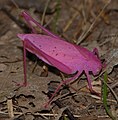Erytrismus
Erytrismus je pojmenování pro zmnožení červeného pigmentu ve zvířecí kůži, srsti, peří nebo vaječném obalu. Erytrismus vzniká buď genovou mutací anebo způsobem stravování. V některých případech jde zřejmě i o způsob maskování. Toto zbarvení může mít velké množství druhů zvířat, například kobylky, hadi, ptáci, šelmy nebo kytovci.
Galerie
Externí odkazy
 Obrázky, zvuky či videa k tématu Erytrismus na Wikimedia Commons
Obrázky, zvuky či videa k tématu Erytrismus na Wikimedia Commons
Média použitá na této stránce
Autor: Keven Law, Licence: CC BY-SA 2.0
European Polecat (Mustela putorius); a juvenile at British Wildlife Centre, Surrey, England.
Highest Explore Position #123 ~ On August 19th 2008.
Baby European Polecat - British Wildlife Centre, Surrey, England - Sunday August 17th 2008. Click here to see the Larger image
European Polecat ~ Mustela putorius ~ A member of the weasel family (Mustelids), polecats were once widespread and common throughout mainland Britain. Relentless persecution by gamekeepers up until the late 1930's resulted in extermination everywhere except for a small population in north Wales. They have since recovered and are now found throughout rural Wales, the Border counties and are spreading across the Midlands, South and into the South-East. They are solitary in nature and active throughout the year. They favoured habitat is woodland, riverbank and surrounding farmland. They will hunt by night or by day for small rodents, birds and insects using a keen sense of smell to locate their prey. They emit a pungent musky odour, particularly when threatened. The polecat is the ancestor of the domestic ferret and can interbreed with them.
Origin ~ Native of the United Kingdom.
Size ~ Male length: 55 cm plus 20 cm tail. Female length: 50 cm plus 16 cm tail - about the same size as a ferret.
Description ~ Sexes alike. Fur long, almost black with purple sheen showing buff undercoat. White markings on face and ears.
Habitat ~ Favours lowland country below 500m in woodland, marsh, riverbanks, farmland and farm buildings.
Young ~ One litter of 3 -7 young born May or June after 40 days gestation. Fully grown in 3 months.
Diet ~ Frogs, water voles, trout, eels, rabbits, snakes and ground nesting birds.
Population Pre-breeding season estimated to be 63,000 and increasing.Autor: Flickr user Richard Whitby, Licence: CC BY-SA 2.0
This katydid really was fluorescent pink. It's not enhanced in any way. The coloration (erythrism) is an adaptation sometimes found among katydids exposed to red or pink foliage, although this one was in the woods off the Appalachian Trail near Mount Peter, N.Y.
Autor: Flickr user Jenny, Licence: CC BY-SA 2.0
Pink-orange katydid on saw palmetto. They are usually green; this is an instance of erythrism. Taken during internship at the Florida Panther National Wildlife Refuge June/July 2005.
Autor: Flickr user Ric McArthur, Licence: CC BY 2.0
A pink katydid at Rondeau Provincial Park, Ontario, Canada. Usually they are green, this is an instance of erythrism.







